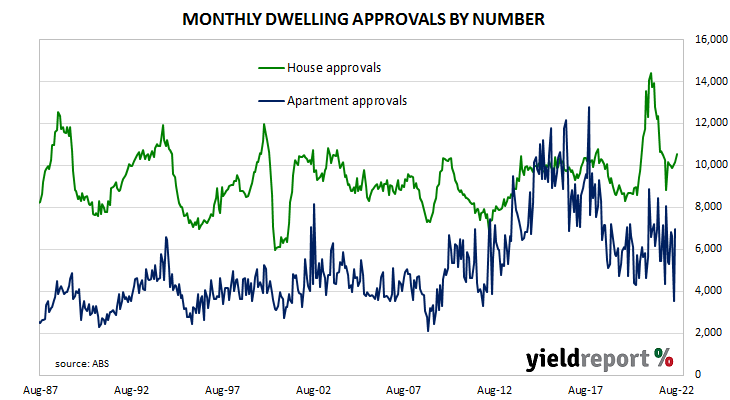Summary: Home approval numbers up 28.1% in July, above expectations; 9.5% lower than August 2021; strong increase in units “suggest some appetite and ability” to continue providing new supply; non-high rise resilience questions extent of drag on growth from policy tightening, other factors; house approvals up 3.7%, apartments up 98.6%; non-residential approvals up 15.1% in dollar terms, residential alterations up 5.4%.
Building approvals for dwellings, that is apartments and houses, headed south after mid-2018. As an indicator of investor confidence, falling approvals had presented a worrying signal, not just for the building sector but for the overall economy. However, approval figures from late-2019 and the early months of 2020 painted a picture of a recovery taking place, even as late as April of that year. Subsequent months’ figures then trended sharply upwards before falling back in 2021 and the first half of 2022.
The Australian Bureau of Statistics has released the latest figures from August and total residential approvals rebounded by 28.1% on a seasonally-adjusted basis. The rise was significantly greater than the 9.0% increase which had been generally expected and in contrast with the 18.2% fall in July. Total approvals fell by 9.5% on an annual basis, above the previous month’s figure of -25.5%. Monthly growth rates are often volatile.
“As this is a very volatile series, we can’t make too much of the August jump, though the very strong increase in units does suggest some appetite and ability on the part of developers to continue providing new supply in response to tight rental markets, despite instability in the construction sector,” said ANZ senior economist Adelaide Timbrell.
The figures were released on the same day as the RBA’s smaller-than-expected 25bps increase of its cash rate target and Commonwealth Government bond yields fell significantly. By the close of business, the 3-year ACGB yield had shed 34bps to 3.34%, the 10-year yield had lost20bps to 3.75% while the 20-year yield finished 13bps lower at 4.04%.
In the cash futures market, expectations regarding future rate rises eased considerably. At the end of the day, contracts implied the cash rate would rise from the current rate of 2.56% to average 2.78% in November and then increase to an average of 2.93% in December. May 2023 contracts implied a 3.555% average cash rate while August 2023 contracts implied 3.565%.
“While there are clearly volatility issues that still need to be resolved, the resilience of non-high rise segments to date continues to question the extent to which policy tightening and other factors will lead to a significant drag on growth from new dwelling investment,” said Westpac senior economist Matthew Hassan.
Approvals for new houses increased by 3.7% over the month after rising by 1.1% in July. However, on a 12-month basis, house approvals were still 14.9% lower than they were in August 2021, up from July’s comparable figure of -16.9%.
Apartment approval figures are usually a lot more volatile and August’s total nearly doubled, up 98.6% after a 47.3% drop in July. The 12-month growth figure recovered from July’s revised rate of -42.8% to +0.2%.
Non-residential approvals increased by 15.1% in dollar terms over the month but decreased by 10.5% on an annual basis. Figures in this segment also tend to be rather volatile.
Residential alteration approvals increased by 5.4% in dollar terms over the month but were 8.8% lower than in August 2021.



